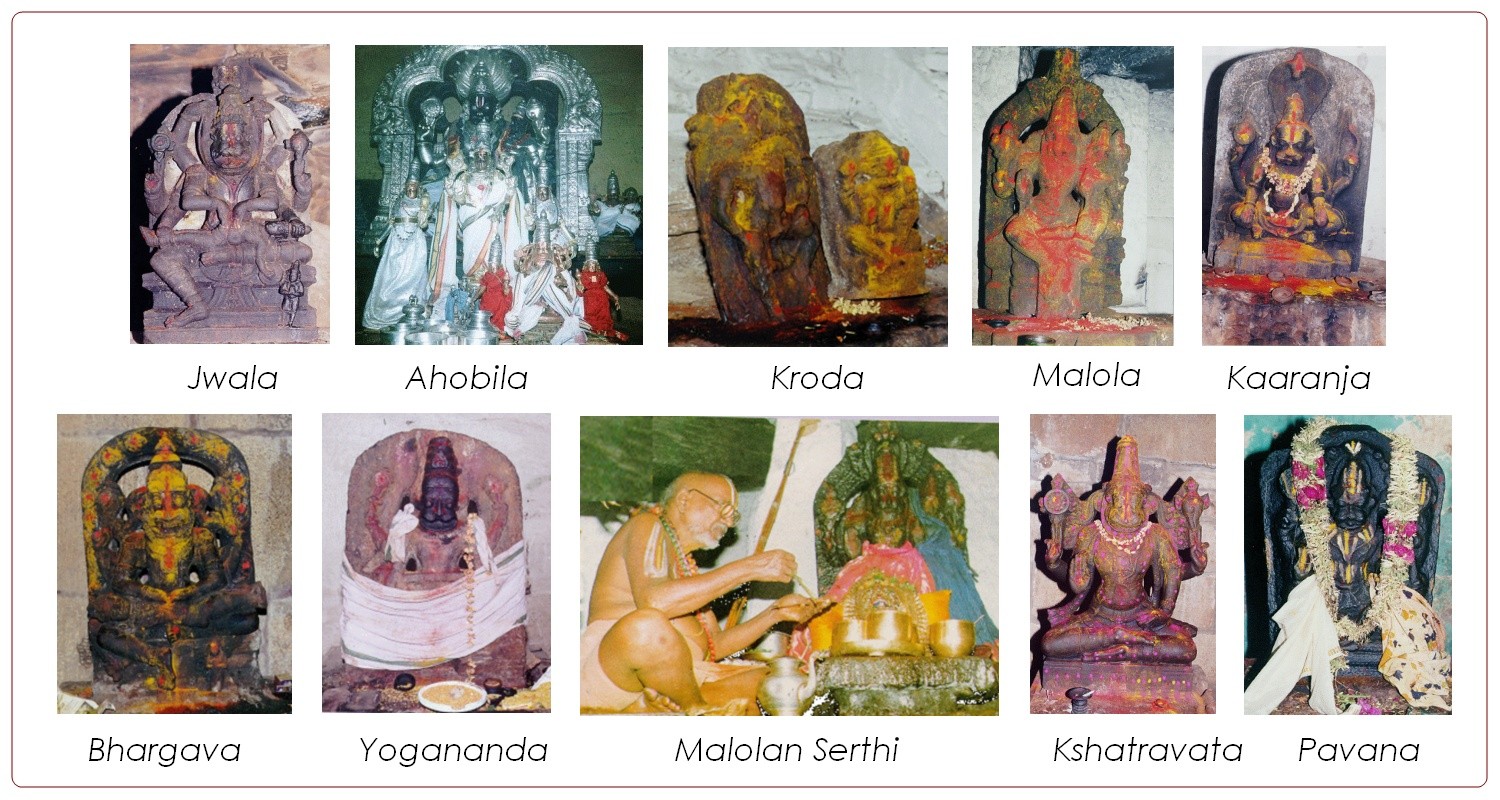Nava Narasimhas – Ahobilam
In Ahobilam, Narasimha Swami is incarnated in nine forms. In Brahmanda Purana, the nine Narasimhas were described as
Jwala Ahobila Malola Kroda Karanja Bhargava
Yogananda Kshatravata Pavana Nava Moorthayaha
Except for two or three temples, all the other temples had to be visited only on footway through the hills.
The Nine Narasimhas sthalas are :-
- Jwala Narasimha
- Ahobila Narasimha
- Malola Narasimha
- Kroda Narasimha
- Karanja Narasimha
- Bhargava Narasimha
- Yogananda Narasimha
- Kshatravata Narasimha and
- Pavana or holy Narasimha.
Before visiting these nine shrines, let us see how we approach the place. Situated in the Nallamalai Hills, Ahobilam is about 24 Kms. from Allagadda Taluk Headquarters, 112 Kms. from Cudappah, and 65 Kms. from Nandyal in Andhra Pradesh and can be reached by bus from Hyderabad and also by rail via Kurnool and then by bus from there.
Long long ago, the Tamil mystic bard, Thirumangai Azhwar sang that Singavel Kunram (Ahobilam) was accessible to none but Gods. Due to the efforts of the current 45th Srimad Azhagiyasingar, the access routes to several of the shrines have been greatly simplified such that people of different age groups are now able to visit the places easily.
The whole complex is in two parts – one called
- Eguvu Ahobilam (Upper Ahobilam) with Nava Narasimha shrines and
- the other is called Diguvu Ahobilam (Lower Ahobilam)
with a single shrine for Lakshmee Narasimha connected by a road, stretching a distance of about 12.8 Km. from Lower Ahobilam to Upper Ahobilam.
The Sthalapurana of Ahobilam in Sanskrit gives an account of nine forms of Narasimha, worshipped here.
BHARGAVA NARASIMHA KSHETRAM
The Bhargava Narasimha Swami is situated at a distance of 2km from the Lower Ahobilam, on a hill, near the sacred pond, known as ‘Bhargava Theertham’, where Bhargava Rama performed his penance. Hence the Lord of the temple is known as Bhargava Narasimha Swami.
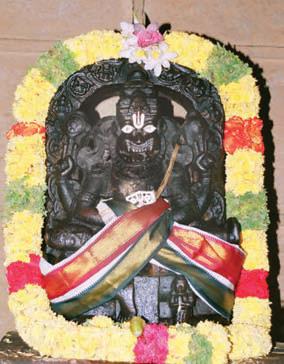
This place is also known as Akshaya Teertham and Bhargoti. Here Swami appears in a posture killing Hiranyakashyapa on his thighs with two hands and holding Conch- Chakra in the other two hands.
YOGANANDA NARASIMHA KSHETRAM
This temple is to the southeast of Lower Ahobilam at a distance of 2km in forest. The popular legend is that after killing Hiranyakashyapa, Lord Narasimha taught Prahlada several yogic postures.
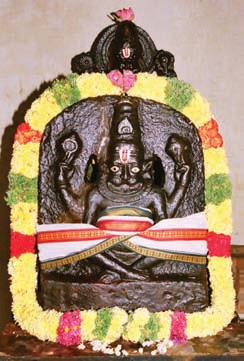
Therefore, the Lord in this aspect is called Yogananda Narasimha. Here Swami appears in yogic posture with two hands placed on knees and holding Conch-Chakra in the other two hands.
CHATRAVATA NARASIMHA KSHETRAM
This temple is about 2km from Yogananda Narasimha temple. ‘Vata’ means peepal tree, ‘chatram’ means umbrella. The image of the deity is installed under a peepal tree, surrounded by thorny bushes. Hence, the Lord is called Chatravata Narasimha Swami.
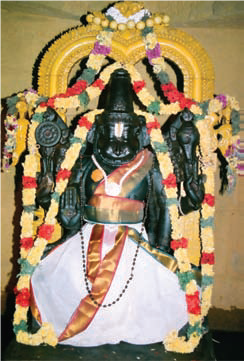
The deity holds the Conch-Chakra in two hands, abhayahastha (hand in a gesture of fearlessness) and the other hand in a posture of enjoying music.
KARANJA NARASIMHA KSHETRAM
This shrine is situated at a distance of 7km from the lower Ahobilam. ‘Karanja’ means Kanuga tree. In Dwaparayuga, when Hanuman came in search of Sri Rama and performed penance here under this tree, Srihari incarnated in the form of Narasimha Swami. Hanuman desired to see Swami as Srirama hence Swami gave darshan with a bow in his hand.
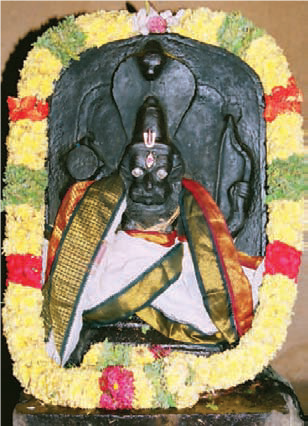
The deity here appears in a meditating posture with Chakra in the right hand and bow in the left hand instead of the conch. The deity has a third eye on the forehead as found nowhere else. Annamacharya praised this deity in his Keerthana “Phalanethraanala prabalavidyullatha”.
KRODA (VARAHA) NARASIMHA KSHETRAM
The temple of this Lord is 1km away from the Upper Ahobilam temple on the bank of Bhavanasini river. The deity is in Hiranyaksha’s killing posture. The image of the deity bears three forms- the face of a boar (varaha or kroda), the body of a human, and the nails of a lion.
The deity is in a standing posture with both his hands on his waist and is seen along with his Consort, Bhudevi, lying on him.
JWALA NARASIMHA KSHETRAM
This temple lies 2km east of upper Ahobila temple on a hill called, ‘Achalachaya Meru’. This place is said to be the actual spot, where the fierce anger of the Lord reached its culmination when he tore Hiranyakashyapa.
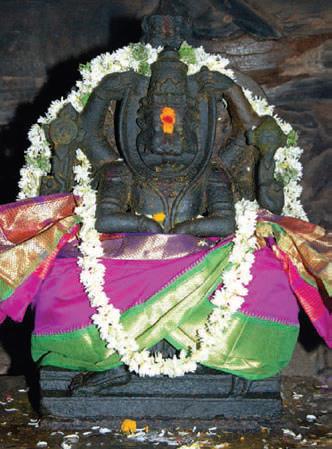
The deity in this cave temple appears in three forms:
- Eight-armed Narasimha Swami,
- Four-armed Narasimha Swami,
- Fierce form of Jwala Narasimha Swami killing Hiranyakashyapa.
The Achala Meru Mountain is divided into two vertical halves with one half slightly bent. In between is the Jwala Narasimha temple. After killing Hiranyakashyapa, Swami washed his hands in the nearby pond as seen today from the water in the pond being red.
MALOLA NARASIMHA KSHETRAM
Nearly two kilometers from the main temple of Upper Ahobilam is the famous shrine of Malola Narasimha Swamy. The deity here appears in ‘Soumya’ (graceful) form. As Lord Narasimha is seen with his consort, Lakshmi, He is known as Malola Narasimha Swamy.
The word ‘Malola’ means beloved to Lakshmi (Ma=Lakshmi, Lola= beloved). It is said that the ‘utsavamoorthi’ of the Lord appeared to Srimath Adivan Satakopa Jeeyar, the first Jeeyar of Ahobila Mutt.
Right from the founder, i.e., the first Jeeyar of Ahobila Mutt down to the 44th pontiff, Srivan Satakopa Sri Vedanta Desika Yatheendra Mahadesika, the present jeeyar, the utsavamoorthi of Malola Narasimha Swamy is worshipped and it is taken by them whenever they are on religious tours, visiting the villages every year.
Recently, the 45th Jeeyar Srivan Satakopa Sri Narayana Yatheendra Mahadesikan has taken over the worship.
PAVANA NARASIMHA SWAMI
Pavana Narasimha is about 6km from the Upper Ahobilam temple, on the banks of the river, Pavani. Hence the deity is known as Pavana Narasimha Swami. River Pavani flows taking the form of a snake hence the deity is also known as Pamuleti Narasimha Swami.
Here Swami appears as Lakshmi Narasimha with Abhayahastha sitting under the shade of Seven-hooded Adisesha. The idols of Navaneetha Krishna (crawling Krishna with butter in hand), Gopala Krishna, Varadaraja Swami, and Hanuman are seen beside.
Beginning with Brahmotsavams to Nrisimha Jayanthi, special utsavas are performed every Saturday. Thousands of devotees participate in these utsavams to have darshan.
Lower Ahobilam
In addition to the shrines mentioned above, there is a famous shrine dedicated to God Narasimha Swamy in the Lower Ahobilam, which is popularly known as Prahlada Varada Sannidhi. The other objects of this place are ‘Ugra Sthambham’ and ‘Prahlada Mettu’.
(a) UGRA STHAMBHAM
At a distance of eight kilometers from the Upper Ahobilam temple, we can see a cleft of the mountain dividing it into two visible parts. It is a long-held view that from the cleft, the Lord appeared in the form of Narasimha and this cleft is known as ‘Ugra Sthambham’.
(b) PRAHALADA METTU
The small shrine, situated in a cave on the hill, is in between Ugra Sthambham and the Upper Ahobilam. It is dedicated to Prahlada Narasimha Swamy. The image of the Prahlada is installed in a small cave.
There are many holy ‘theerthas’ (water ponds) around this place. Of these, Rakthakundam is the most important. It is stated that Lord Narasimha after killing the demon Hiranyakasipu, washed his hands in this ‘theertham’ and hence the water is still reddish in appearance.
